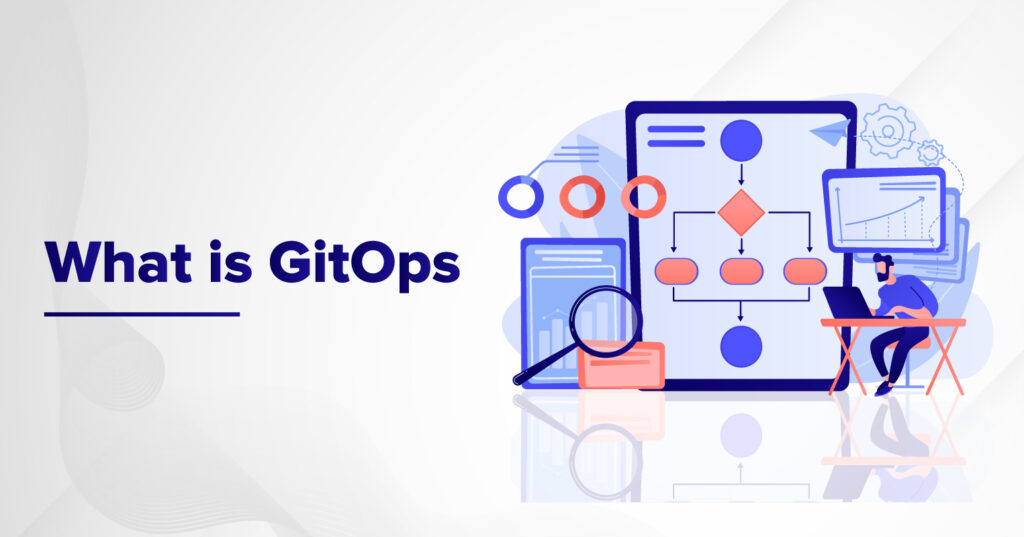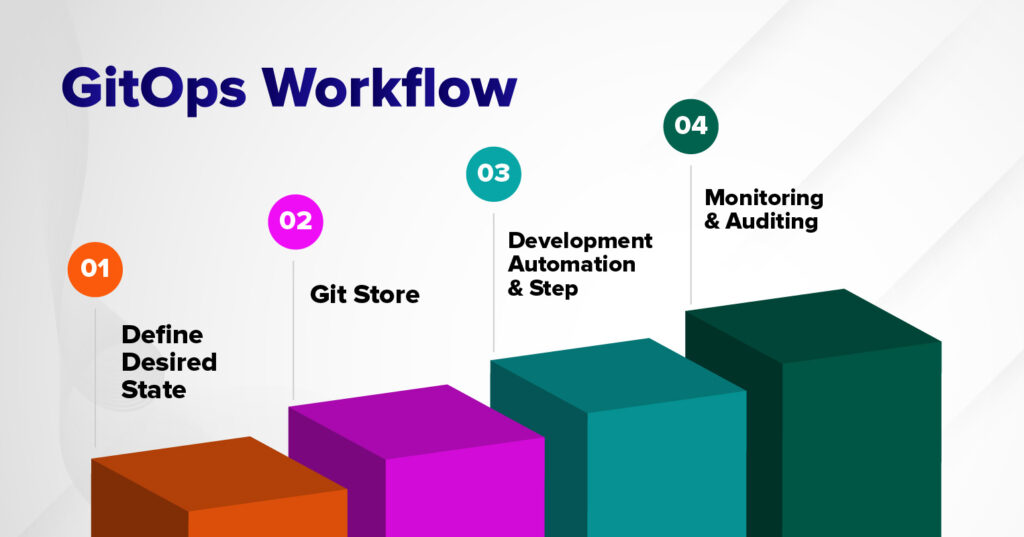What is GitOps? It’s Definition & Implementation in DevOps
14 +
Years of Experience
550 +
Happy Customers
250 +
Years of Tech Leadership Exp.

"License Reseller" and "Consulting & Implementation" Partner

Efficiency, reliability, and speed are the primary concerns with software development today. Traditional DevOps methodologies are always undergoing refinements to meet the increasing demands of modern software delivery. One of the latest developments in this area is GitOps, a method of taking advantage of Git as a single source of truth for managing infrastructure code.
What does GitOps mean?
GitOps refers to a set of practices that make use of Git repositories as sources for declarative infrastructures and application environments. Essentially, it assumes management of an entire system’s desired state using version control capabilities provided by Git. The following are advantages associated with this approach:
- Version Control: Every alteration is versioned and traceable.
- Collaboration: Pull requests and code reviews enable teams to work together.
- Automation: Changes can initiate automatic processes that update environments.
- Traceability: Changes can be easily traced back to particular commits
However, in reality, this implementation simply transfers key DevOps concepts to infrastructure management. Therefore, making changes in infrastructure is as reliable and easy as modifying application codes.
The 4 Commandments of GitOps
- Declarative Configuration:
- All descriptions of infrastructure and application configuration should be declarative.
- The desired state of an infrastructure component should be written in YAML or JSON files.
- Versioned and Immutable:
- Store configuration files in version control systems like git.
- Immutability is guaranteed by making each change create a new version.
- Automatically Applied:
- Changes from the git repository will always be applied automatically using automated workflow.
- Continue reconciling the desired state with the actual state by utilizing tools such as Kubernetes operators.
- Continuously Monitored and Audited:
- Monitor the environment to ensure it matches the desired state defined in Git.
- Implement auditing to track changes and identify discrepancies.
Use Cases for GitOps
Continuous Deployment
The deployment process is automated to simplify continuous deployment via GitOps. In other words, by having a change pushed to the Git repository, an automated pipeline can be triggered, leading to its deployment, to ensure that the live environment always reflects the desired state.
Infrastructure as Code (IaC)
Infrastructure as Code management is a strong point for GitOps. This means that teams can easily manage their infrastructure changes systematically and securely by keeping them as configurations in Git with powerful features such as branching, merging, and pull requests.
Disaster Recovery
GitOps makes disaster recovery easier. Whenever there is a failure, one simply needs to check out the last known good state from git and apply it in the environment for recovery.
Compliance and Auditing
There is complete accountability because every modification can be traced back to a certain commit, thus allowing a clear audit trail through GitOps. This is especially useful for organizations that have strict compliance rules.
Challenges & Benefits of GitOps
Challenges
- Complexity: Usually, it may be difficult to execute GitOps, particularly for firms that are new to infrastructure as code (IaC) and continuous delivery.
- Tooling: The uptake of Kubernetes and other specific tools platforms might hinder its acceptance.
- Cultural Shift: Embracing GitOps will mean a major change in the company’s culture. To handle infrastructure and deployments differently, teams must switch lanes.
Benefits
- Improved Collaboration: This allows for more efficient teamwork across all departments by using a familiar interface as well as workflows backed up by Git.
- Enhanced Security: It is through version control on Git that security concerns can be taken care of safely.
- Faster Recovery: If any failure occurs, the system can easily be returned to its normal state within no time.
- Scalability: For big teams or when there are complex environments, then GitOps becomes more scalable.
GitOps vs. DevOps
While GitOps is a subset of DevOps, it brings a unique approach to managing infrastructure and applications. Here’s how they compare:
- DevOps focuses on improving collaboration between development and operations teams, emphasizing automation, continuous integration, and continuous deployment.
- GitOps extends these principles by using Git as the single source of truth, automating the application and infrastructure management processes.
In essence, GitOps can be seen as an evolution of DevOps, providing a more structured and auditable approach to managing infrastructure and application deployments.
GitOps Workflow

A typical GitOps workflow involves several key steps:
- Define Desired State: Use declarative setup files to define how the infrastructure and applications should be.
- Git store: Commit configuration files into the Git repository.
- Deployment automation: Use CI/CD Pipelines to automate deployment. Tools like Argo CD and Flux can continuously match up real-time state with the desired one.
- Monitoring and Auditing: Continuous monitoring of the environment is conducted to ensure that it matches the required status. Introduce auditing to track variation in results across time.
Future of GitOps
In the future, other companies will definitely adopt this approach since they may realize that essentially everything that has to do with infrastructure and application management is essentially managed through git:
- Increased Adoption: More organizations are predicted to adopt GitOps as they recognize the advantages of a Git-centric approach in managing infrastructure and applications.
- Enhanced Tooling: The ever-expanding ecosystem of GitOps tools will provide a myriad of choices.
- Integration with Other Technologies: Increasingly, integration between GitOps and other emerging technologies, such as server less computing or edge computing, will occur.
- Focus on Security: As security continues to dominate conversations, stronger security measures will be put in place by GitOps practices.
Best Tool to Include GitOps: Octopus Deploy
Octopus Deploy is a powerful tool that improves GitOps practices by automating complex deployments and release management across multiple environments. It provides an effective platform to implement GitOps, which helps teams improve their deployment processes and ensure uniformity in different environments.
Benefits
- Automated Deployments: Octopus Deploy automates the deployment process, reducing the risk of human error and ensuring consistent deployments.
- Environment Management: It provides tools for managing multiple environments, making it easy to deploy changes across different stages of the software development lifecycle.
- Integration with CI/CD Tools: Octopus Deploy integrates seamlessly with popular CI/CD tools, enhancing the GitOps workflow.
- Advanced Deployment Strategies: Supports advanced deployment strategies like blue-green deployments, canary releases, and rolling updates.
How Do Teams Put GitOps into Practice?
- Adopt Declarative Configurations: All infrastructure and application settings should be in declarative configuration files.
- Use Git as the Source of Truth: Commit all configuration files to a Git repository and use pull requests to manage changes.
- Automate Deployments: Implement CI/CD pipelines to automate the deployment process.
- Continuous Monitoring: Continuously monitor the environment to ensure it matches the desired state defined in Git.
- Implement Security Best Practices: Use Git’s security features to manage access control and ensure the integrity of configuration files.
How DevTools Can Help You with GitOps?
For over a decade now, DevTools has remained an ideal choice for the Software Delivery & Maintenance Community due to its assistance in helping organizations implement and integrate DevSecOps tools. We are also considered for the processes for speeding up the software development lifecycle. DevTools was instrumental in spearheading the growth of Digital Transformation along with DevSecOps for a decade. In order to support GitOps implementation, DevTools provides a full range of services, including consulting services, to help organizations effectively implement GitOps practices. We also offer tool integration support, allowing them to integrate GitOps tools seamlessly into their existing DevSecOps processes and platforms. Our managed services ensure the smooth and efficient running of ongoing GitOps operations. Additionally, we provide extensive training and support aimed at assisting teams in adopting and optimizing GitOps practices and tools provided by this company.
Conclusion
DevOps, GitOps is a new way of managing infrastructure and the deployment of programs based on Git. In this way, it becomes possible to have better consistency, reliability, and security in the deployment processes within the teams by considering Git as one source of truth. By implementing GitOps with appropriate tools and practices, organizations can simplify their workflows, promote collaboration, and speed up the software delivery life cycle.
FAQs
It comes with many benefits, such as improved collaboration, better security, faster recovery time, and scalability. Familiar git workflows allow teams to manage changes in infrastructure or applications with clear audit trails and deploy them automatically.
In a git repository, declarative configuration files are stored, which define how gitops works. Consistency is maintained between the expected state defined in git over time and the actual environment using automated processes for reconciliation.
GitOps enables teams to deploy automation capabilities around these configurations instead of only versioned Infrastructure as Code, monitoring everything continuously while reconciling all changes made on the underlying systems.
Yes, GitOps is often thought of as a Kubernetes thing, but the ideas behind it can be used with other platforms and situations. You just need to ensure that Git is the source of truth and make your deployment automatic.
GitOps is able to manage DEV to PROD propagation through automated CI/CD pipelines. Pull requests and automated deployment processes promote changes from one stage (development) to another (testing, production).
No, it isn’t. GitOps still needs operational oversight and intervention for functional operations. Nonetheless, it lessens their routine errands by automating, thus allowing them to focus on higher-level concerns.




